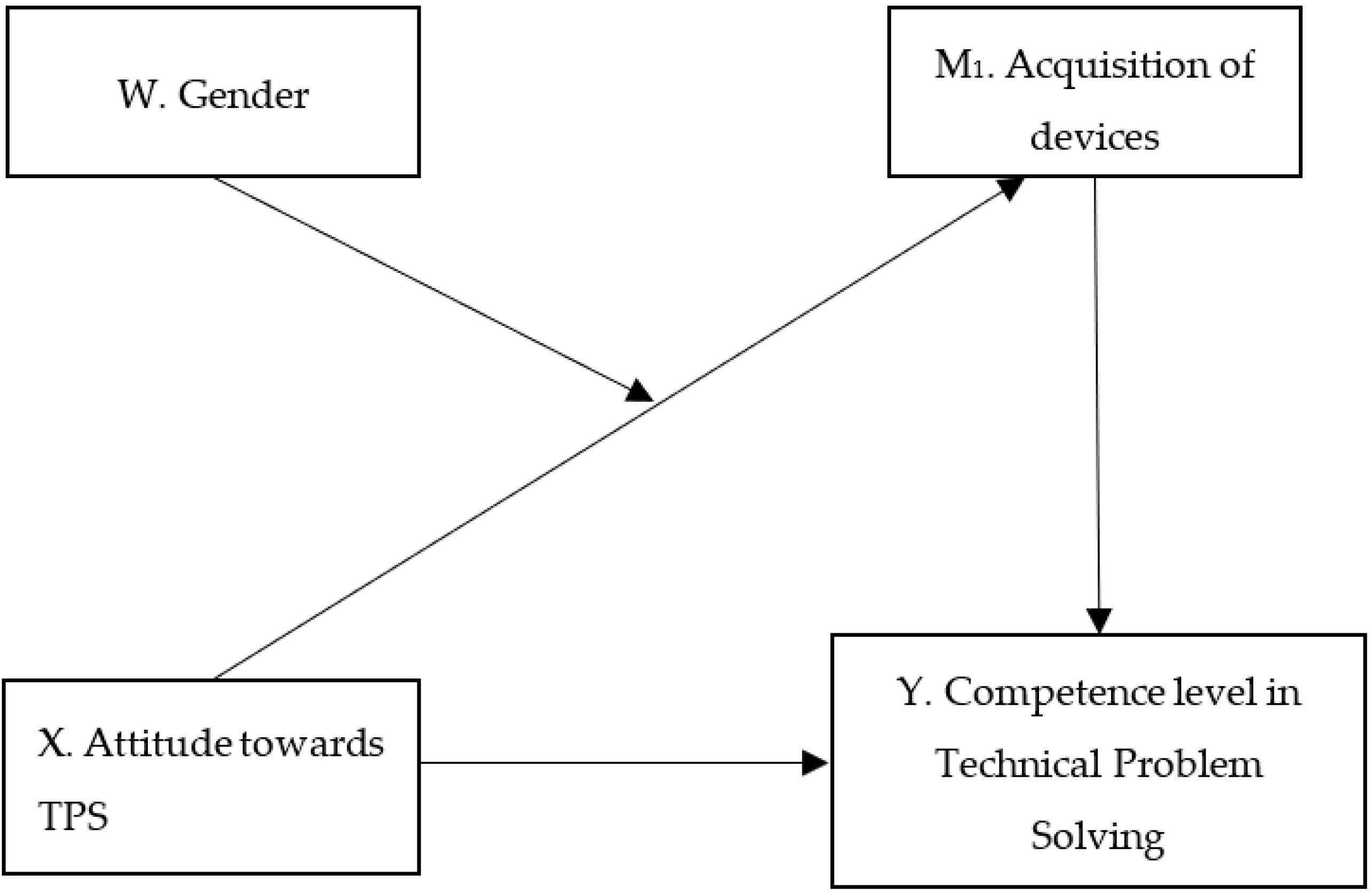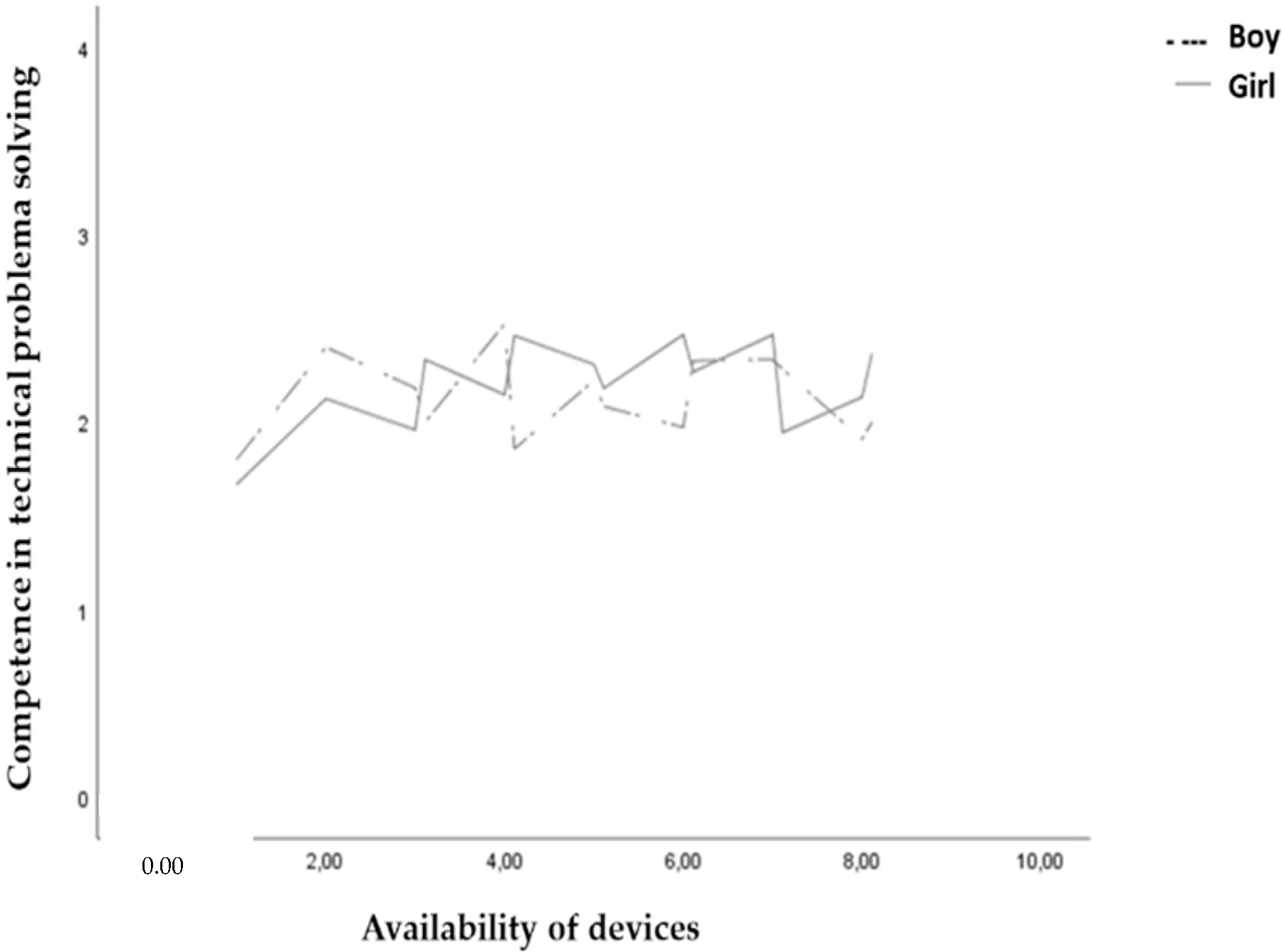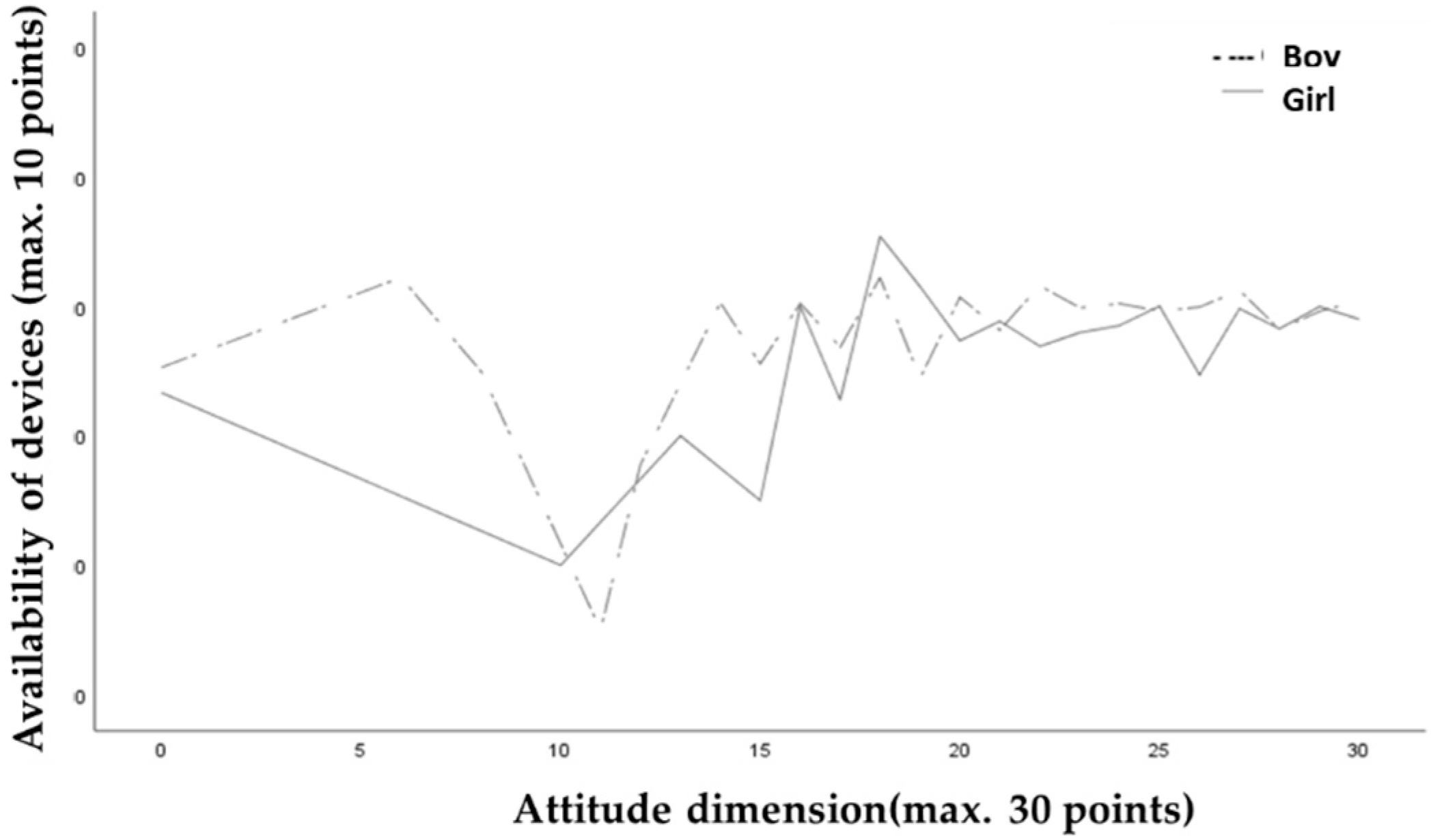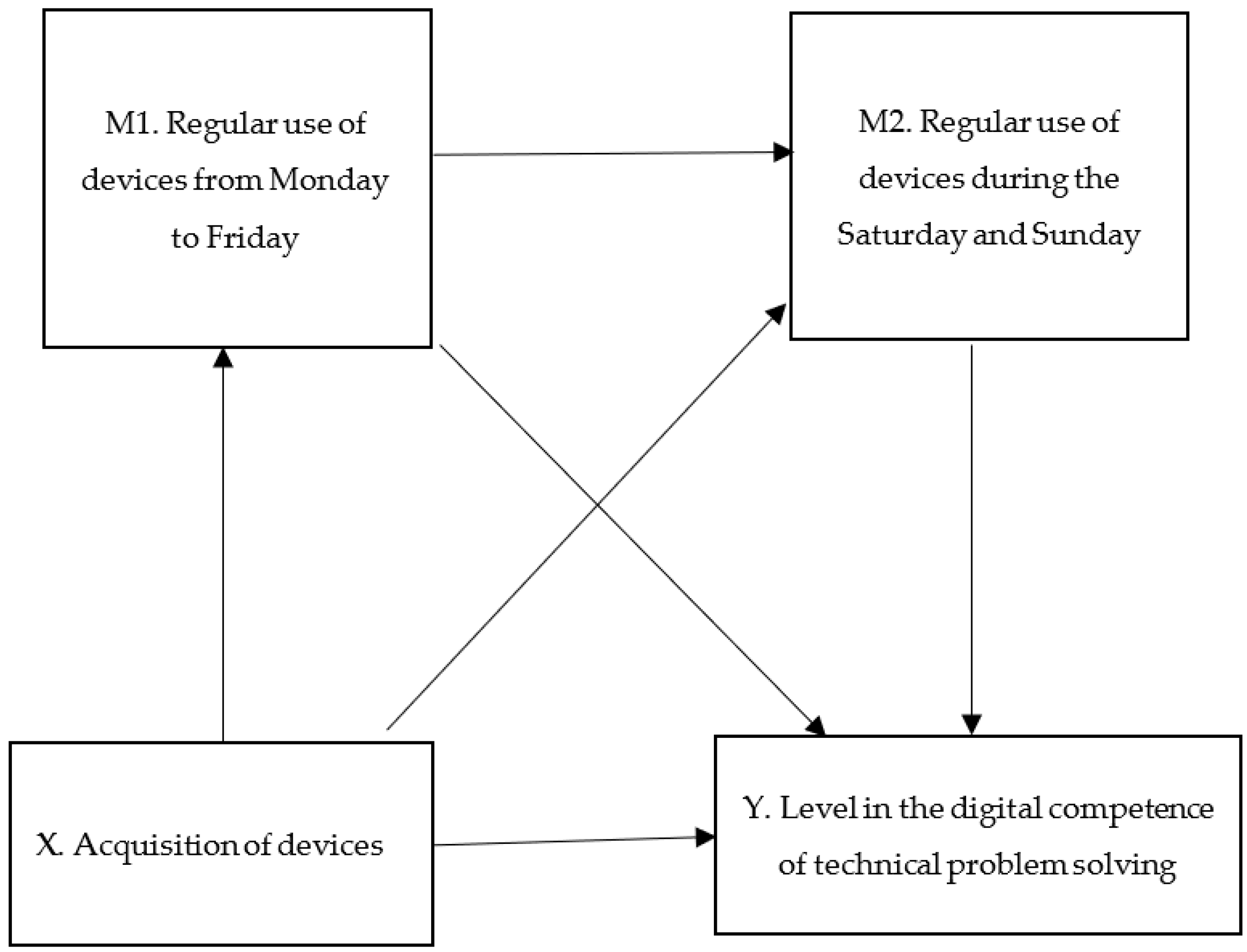1. Introduction
Information and Communication Technologies (ICTs) have strongly impacted the new global scene, changing how people communicate, work, study, and do business [
1]. ICTs can improve education quality and accessibility, but they may also pose challenges in terms of digital divides and students’ skills [
2]. Digital education, understood as the set of knowledge (knowing), skills (know-how), and attitudes (knowing to be) that are required for the proper acquisition and development of digital competence, is an indispensable requirement to integrate technology into the teaching and learning processes for schoolchildren.
Digital competence will become essential for countries’ future economic and social prosperity [
3] and, consequently, its early development in children and youth should be regarded as a basic necessity [
4].
The term digital competence is often used in research to refer to a set of abilities that are needed in the digital environment [
5]. From our point of view, digital competence refers to the set of knowledge, skills, and attitudes that is required for the safe, critical, and responsible use of digital technology in the personal-individual, professional, and social spheres.
For over a decade, in the European Union and beyond its borders, the Framework for Developing and Understanding Digital Competence in Europe (DigComp) has been a source of common understanding of what digital competences are and has provided a basis for the development and assessment of digital competence, serving as a reference for digital competences policy [
6].
This framework has gradually evolved from DigComp 1.0 [
7] to 2.2 [
8], moving through DigComp 2.0. [
9] and DigComp 2.1. [
10].
According to this framework, digital competence encompasses five areas. This research focuses on area five, regarding problem solving (PS), specifically on the competence of technical problem solving (TPS). The area of PS refers to identifying digital resources and needs, making decisions about the most appropriate digital resources given the purpose or need, solving theoretical problems through digital resources, creatively using technology, solving technical problems, and updating competences. The competence of TPS establishes that the user should be able to identify potential technical problems and solve them, from the most basic to the most complex. The decision to focus our research on this area and competence was made because, a priori, children between the ages of 12 and 14 are considered to have a good instrumental command of technology. Children use technologies mostly as content consumers, but many are not able to solve simple technical problems using the Internet as a source of information, which is an important skill for using devices in an autonomous and safe way. In this sense, no specific studies have been carried out on this issue. On the other hand, this competency area intersects with the rest of the competency areas.
Most of the research on digital competence carried out in the last decade has focused on the self-assessment of this ability by those investigated, obtaining results of self-perception [
11,
12,
13,
14]. On the other hand, less research has focused on the influence that certain personal variables may have on the acquisition and development of this competence [
15,
16,
17]. The work presented in this paper goes beyond mere self-perception, by presenting results obtained through a real evaluation of digital competence, and investigates whether the development of digital competence may be affected by personal variables.
After a review of the scientific literature on the impact of different variables on the level of digital competence, it should be noted that recent studies have proved that although schoolchildren use ICT to a high degree, this does not ensure that they have adequate levels of digital competence [
18,
19,
20,
21]. Studies have also revealed the impact of personal variables [
22,
23,
24], academic variables [
25,
26], and variables associated with the use of technology [
27,
28,
29] on digital competence levels.
Gender is one of the personal variables that have been more widely examined, and while certain studies regard it as a significant predictor of the level of digital competence [
30,
31,
32], others do not [
33,
34]. The findings reported by the studies conducted have tilted the balance towards a better level of competences in the male population [
35,
36], and the latest research continues to reveal a digital divide that is to the detriment of the female gender [
37,
38,
39].
On the other hand, access to digital devices at home also defines the level of digital competence, with some studies reporting that the higher the number of devices and the more frequently they are used, the better the level of competence [
40]. However, others claim that such variable has no influence on improving digital competence [
41]. Nonetheless, it seems that having digital devices and using them frequently leads to an increase in schoolchildren’s digital skills when they are used for recreational rather than academic purposes [
28,
42].
With the purpose of delving further into the factors that influence the improvement of schoolchildren’s digital competence, this study uses theoretical mediation models with the aim of identifying the relationship between personal and access to devices at home variables and the level of digital competence in the technical problem solving of Spanish schoolchildren aged 12 to 14. Although mediation models are a novelty in educational research, they have been used for years in the scientific area of psychology to study the processes involved in producing a functional relationship or an effect. To achieve the same purpose, the influence of the attitudinal component is also analyzed. This component is understood as the willingness to act in a certain way and is based on people’s beliefs and predispositions when dealing with a specific situation involving technology [
43].
The present work was developed in the context of the R&D research project called “Evaluación de la competencia digital de los estudiantes de educación obligatoria y estudio de la incidencia de variables sociofamiliares—Assessment of the digital competence of compulsory education students and study of the incidence of socio-familial variables”, financed with public funds and whose reference is EVADISO, EDU2015-67975-C3-3-P, MINECO/FEDER.
The article is structured in four sections. The first, called Introduction, briefly presents the theoretical framework that contextualizes the research carried out. The second section explains the materials and methods used to conduct the study presented. The third section presents the main results obtained, and in the fourth and final section the results are discussed and the main conclusions reached are collected.
2. Materials and Methods
Mediation models were used with the aim of proposing explanatory theoretical models that help to identify and understand the influence of certain variables on others. They involve a set of two or more causal variables chained in a sequence (X/M/Y), in such a way that the mediator variable (M) must be causally located between X and Y and must be affected by X, which, in turn, must affect Y. This type of analysis is based on a cross-sectional research design where data are gathered from a sample at a specific point in time, using quantitative methods for their analysis [
44].
The purpose was to verify the relationships between the different study variables. Specifically, the focus is on establishing whether certain personal variables of students affect competence development, associated with the solving of different technical problems that may arise when using technological devices.
This general objective takes shape in the following specific aims:
To analyze the influence of schoolchildren’s attitude towards the competence area of problem solving (PS) on the level of digital competence in technical problem solving (TPS).
To analyze the influence of acquisition of digital devices and students’ gender on the attitude towards the competence PS.
To analyze the impact of acquisition and regular use of digital devices at home on the competence level TPS.
To analyze the influence of use of devices at home (as a mediator variable) and gender (as a moderating variable) on attitudes towards the acquisition of digital competences.
In line with these objectives and based on the review of the literature, two hypotheses are posed:
Hypothesis 1: A positive attitude towards problem solving leads to greater access to devices at home and a higher level of competence, while gender is not an influential variable.
Hypothesis 2: The more digital devices available to students and the greater the regular use, the better their level of competence in technical problem solving, while gender is not an influential variable.
2.1. Sample
The assessment of students’ digital competence was carried out in 18 education centers in the Autonomous Community of Castile and León (Spain). The sampling method used was stratified random sampling and the sample consisted of 772 students (from 12 to 14 years old), which entails a +4% margin of error for a 95% confidence interval. The distribution of the sample by gender is 391 women (50.6%) and 381 men (49.4%).
All the participants and their legal guardians were informed of the purposes of the study and signed an informed consent form to freely participate, following the considerations of the Ethics Committee of the University of Salamanca.
2.2. Assessment Tool
The assessment test was designed based on a validated indicator model [
45] to evaluate students’ digital competence (INCODIES
®) taking the DigComp 1.0 framework as a reference. This model can be found in [
46].
A 16-item bank was designed for the competence area PS to assess the dimensions of knowledge and skill of the four digital competences that it encompasses. A battery of tests was refined through expert reviews in the field. Subsequently, an assessment test was created based on this battery, which was applied to a pilot sample of 288 compulsory education students. With the results obtained from this pilot sample, the final test called ECODIES
® was developed [
47]. Its validation process is described in a paper [
48], where it is explained how the validity and reliability of the test was assessed through various methods.
Specifically, the technical problem solving digital competence was measured using four items (two knowledge and two skill, three intermediate level and one advanced) (
Table 1). The contents of the items refer to sources of information that can be consulted on the Internet for the resolution of technical problems; problems with blocking an application program; problems with switching on a computer monitor; and problems with updating device drivers.
Students’ attitudes towards the competence areas were assessed using a previously validated Likert-type scale, out of which the 6 items with the greatest discriminatory power were extracted. Additionally, the items aimed at gathering personal information and information regarding access to digital devices at home were formulated.
The assessment test was applied to students during the 2017–2018 academic year.
2.3. Study Variables
The following variables were studied:
Dependent variable, defined by compulsory education students’ level of digital competence in technical problem solving (TPS).
Independent variables, determined by (a) acquisition of devices (AD), defined as obtaining electronic devices for personal or academic use; (b) attitude towards technology (ATT).
Mediating variables, in the form of (a) regular use of digital devices from Monday to Friday (FW) and (b) regular use on Saturday and Sunday (FWE). Both are defined by the time spent using devices outside school hours.
Moderating variable, determined by students’ gender (G).
2.4. Data Analysis
Data were analyzed using mediation and regression analyses to test the suggested hypotheses. The novelty contributed by this study is that it does not use traditional regression analyses [
49] but focuses on the use of mediation models [
50,
51].
PROCESS v.3 macro for SPSS v.25 software was used based on the bootstrapping technique. Specifically, two models were proposed: a moderated mediation model, labelled as A (model 59) [
52], and a mediation model, labelled as B (model 6) [
52].
4. Discussion and Conclusions
Digital skills are increasingly useful and necessary in today’s society, in the job market, and in everyday life [
53]. Moreover, they hold the potential to exert a substantial influence on individuals’ welfare and standard of living, along with promoting digital accessibility and equitable opportunities. Therefore, it is important to research the digital competence of future generations, focusing on variables that can affect their proper development.
This research used mediation models to identify the impact of personal variables on the evaluation of the digital competence of technical problem solving in Spanish compulsory education schoolchildren (aged 12–14).
4.1. Influence of Attitude, Access to Digital Devices, and Gender on the Development of Digital Competence in Solving Technical Problems
According to the moderated mediation theoretical model A proposed, and taking the first posed hypothesis into account, there is a positive, though nonsignificant, relationship between students displaying a better attitude towards the competence area PS and a greater level of digital competence in solving technical problems. There is also a relationship between access to a larger number of digital devices at home and a more positive attitude towards the competence area of PS, but without improving the digital competence of solving technical problems. There was no proof of gender moderating any of the formerly mentioned relationships. Because of all this, the first hypothesis is rejected.
The findings are in line with the results of those studies that state that the influence of the attitudinal component is moderate or not relevant [
54,
55,
56] but differ from the results of those where attitude is claimed to be a predictor of digital competence [
57,
58,
59]. Regarding the gender variable, the results obtained in this research disagree with recent studies whose authors conclude that the competence level of the male population in the area of PS and in the digital competence of technical problem solving is higher [
23,
60,
61].
4.2. Influence of the Acquisition of Digital Devices and Their Habitual Use on the Development of Digital Competence in Solving Technical Problems
Considering theoretical mediation model B and the second hypothesis posed, we can assume that a greater acquisition of digital devices has a very significant influence on the regular use of such devices. However, the degree of proficiency in solving technical problems is not notably influenced by possessing a greater quantity of devices or utilizing them more frequently. Hence, the second hypothesis is rejected.
These results match those of other studies, where it is noted that exposure to, use of, and coexistence with digital devices does not entail an appropriate development of digital competence [
62,
63]. As suggested by the results of the mediation analysis yielded by the research carried out by [
42], frequency of ICT usage in the family environment seems to be less significant than other variables for the improvement of digital competence.
4.3. Final Theoretical and Practical Considerations
If we try to relate the two theoretical models used (A and B), we can conclude that both confirm that the acquisition of digital devices has a positive, although not significant, influence on the improvement of competence level in TPS.
After analyzing the two theoretical models presented, we found that neither gender, nor attitude towards the problem solving competency area, nor having more digital devices and using them regularly, have a significant influence on the improvement of digital competence in technical problem solving. Therefore, it can be considered that these personal variables studied do not determine either the acquisition or the development of digital competence.
To assess the digital competence of schoolchildren and examine the influence of different personal variables on it is an important task, since the results obtained provide relevant information to guide the use of technology in education centers. The main educational implications of these findings lead us to conclude that neither a positive attitude towards the digital competence of solving technical problems, nor greater access to digital devices at home, nor gender, define a higher competence level. Having a larger number of digital devices and using them more frequently does not ensure that students will have a better level of digital competence in TPS. Therefore, to integrate ICT into education processes, it is not enough to provide students with technological devices, but it is necessary to design and develop digital education curricular proposals that focus, from the earliest stages (early childhood education), on the development of the different digital capacities contemplated in the different areas of students’ digital development competence. Although there are programs in Spain for the improvement of digital skills among students aged 6–12, such as the DigiCraft program of the Vodafone Spain Foundation (
https://digicraft.fundacionvodafone.es, accessed on 12 April 2023), it is recommended that the development of students’ digital competence be addressed both in a cross-cutting way and as a specific teaching and learning area within the different curricular programs of the different educational stages.
Finally, it is worth noting that the primary constraint of this research is the atomized nature of the work, which focuses on examining the influence of specific variables on a particular digital competence (technical problem solving) in a distinct area (problem solving) of digital competence. This is detrimental to the development of a more holistic view of the studied phenomenon.













